Affordable rents will bring some Lower Puna residents back home
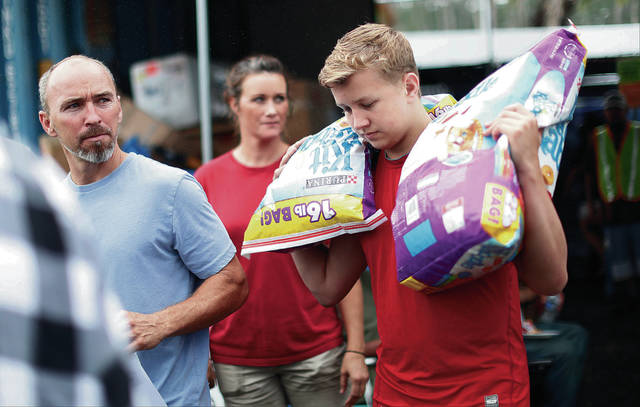
JAMM AQUINO / JAQUINO@STARADVERTISER.COM
Leilani Estates residents Birdy Smith, left, wife Joanie and their son, Jadon, 15, prepared to bring supplies to neighbors still inside Leilani Estates at the Puuhonua o Puna facility Sunday in Pahoa, Hawaii.
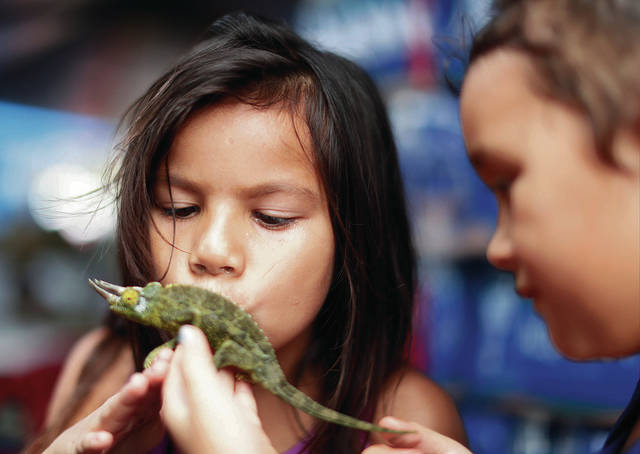
JAMM AQUINO / JAQUINO@STARADVERTISER.COM
Kapua Freitas, 8, kissed a rescued Jackson chameleon Sunday at the Puuhonua o Puna facility.
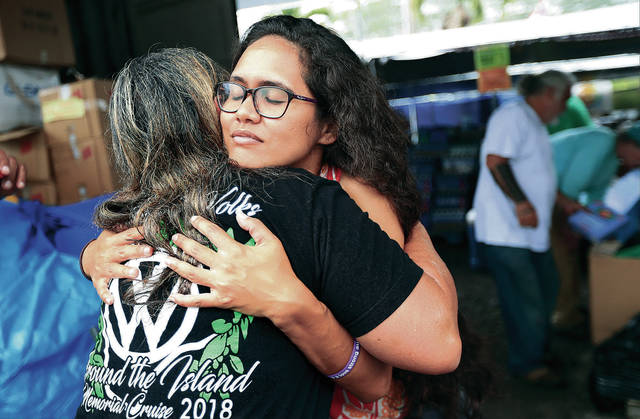
JAMM AQUINO / JAQUINO@STARADVERTISER.COM
Waimea resident Debi Motta, left, hugged volunteer Keala Martins-Keliihoomalu on Sunday after accepting donations for evacuees at the facility.
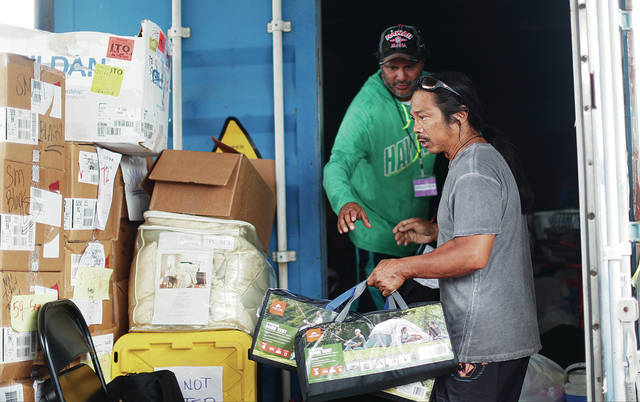
JAMM AQUINO / JAQUINO@STARADVERTISER.COM
Volunteers Rick Masihuddin, left, of Hawaiian Paradise Park and Darrell Lapulapu of Waikoloa sorted through donated supplies Sunday at the Puuhonua o Puna facility in Pahoa.
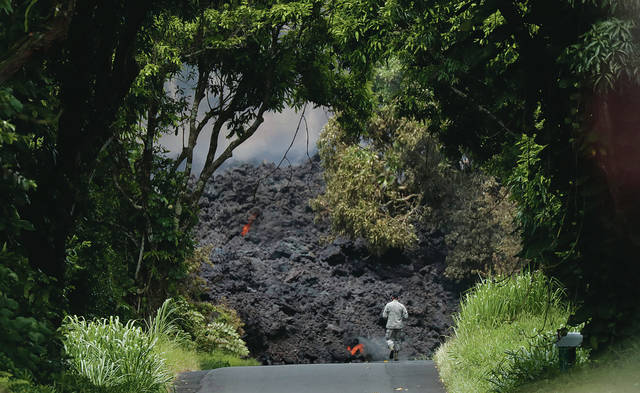
JAMM AQUINO / JAQUINO@STARADVERTISER.COM
Lt. Col. Charles Anthony with the Hawaii Air National Guard monitored sulfur dioxide levels Sunday near the lava flow that overran Highway 137 in Pahoa, Hawaii.





PAHOA >> Everyone who evacuated from Lower Puna has a story about how they’ve spent the past 2-1/2 weeks since Kilauea Volcano began sending lava into their community.
Leilani Estates resident Birdy Smith, wife Joanie and their teenage son, Jadon, are among those who have been able to avoid going into a shelter.
Since leaving their Moku Street home May 4, the family has stayed in three different houses: a few days in Umauma, then a few days in Volcano and now at a place in Hilo where they’ll be able to stay for about a month. The Smiths own a handyman service for people who rent out their homes as vacation rentals, so they’ve been allowed to stay for free at those houses when they haven’t been rented.
>> Affordable rents will bring some Lower Puna residents back home
>> Big Isle leads nation in sulfur dioxide emissions
>> North Carolina sends emergency and fire officials to help in Hilo
>> Big Island family finds Tutu Pele terrifying, but merciful
>> Photos: Lava flow at Leilani Estates, May 20
>> Photos: Lava flow on Highway 137, May 20
>> Photos: Residents learn to move on under Pele’s mercy, May 20
>> Live webcam atop Halemaumau Crater
COMPLETE KILAUEA COVERAGE
>> Star-Advertiser volcano coverage
>> Kilauea Volcano YouTube playlist
“They’re letting us stay there while we do some work on their property,” said Smith, who is from Arkansas. “We’re blessed, very blessed.”
Don't miss out on what's happening!
Stay in touch with breaking news, as it happens, conveniently in your email inbox. It's FREE!
When Leilani Estates resident Kenneth Haymer, his sister and her five kids evacuated from their Maile Street house, he didn’t know where to go.
His sister and her family went to stay with a friend, “but I don’t get along with the people over there,” he said.
“At first I was just roaming the streets,” Haymer said. “I thought (the flow) would just come through and pass on. I didn’t think it would get more drastic.” About two days in, someone told him about the American Red Cross shelter at the Pahoa Community Center, and he’s stayed there ever since.
The accommodations at the shelter have been OK, he said, stressing that the volunteers have been extremely friendly and helpful. “It’s a little bit crowded, but everybody’s trying to do what they can to get along as we go through this tragedy.”
Smith and Haymer, who were having a meal at the community-started Puuhonua o Puna Information and Supply Hub, will likely have vastly different stories to share decades from now about how they spent their time in the weeks after the 2018 Kilauea eruption.
But they both share a common hope: to move back to their houses, even if they may be living in the shadow of a freshly baked lava field.
One big reason is economics.
Haymer and his family have lived at their house for nearly six years — paying $650 a month for three bedrooms and one bath — and feel invested and rooted there.
“It’s rough because we’re on welfare income and we only have so much,” Haymer said, noting that it’s only by pooling their resources that they’re able to stay at the house. “We have a set income and a set food amount,” the Sacramento, Calif., native said. “That’s what we survive on.”
Haymer said he’s hoping he can return. “It could get better or it could get worse,” he said. “We don’t know yet. She’s taking her course.”
If the house is destroyed, the family will move to Texas, where they have relatives.
Smith said he and his family had just gone to their Pomaikai Street house to mow the lawn and “clean the place up a little bit” before lunching at Puuhonua.
“We like the area. We kinda feel like it’s home,” Smith said. “As long as it’s safe, I’m fine with it.”
The Smiths also have a good relationship with all their neighbors, but the place is nothing special, he said.
The family has been at their place for almost two years, paying $500 a month for a two-bedroom, one-bath house with a big yard and lots of fruit trees. The same type of house in Hilo would cost at least three times that much, Smith said.
“It’s really about the only place we can afford,” he said. “Things seem to be a little expensive down here. We don’t have a lot of money.”
“We tried to the buy the place, and we went to try to get a loan for it but they told us it’s in Lava Zone 1, so they can’t loan us,” Smith said. “Thank the Lord we hadn’t because I’m glad we don’t own it now. I may still try to buy later, if things settle down.”
After two dramatic days of the ongoing eruption forcing more emergency evacuations and the lava flow reaching the ocean, Sunday was relatively quiet.
Lava crossed Highway 137 and entered the ocean at about 11 p.m. Friday from two flows, both near each other in an area known as Malama Flats between MacKenzie State Recreational Area and Isaac Hale Beach Park. Both flows emanated from fissure 20 in Leilani Estates several miles up the coast.
The flow fronts moved more quickly than had been anticipated.
Jim Kauahikaua, a geophysicist with Hawaiian Volcano Observatory, said the sped-up trek to the Pacific Ocean was a good example of how unpredictable a pahoehoe lava flow can be. It’s largely determined by the terrain and the composition of the magma.
As of Sunday afternoon the flows were about 200 yards wide and separated by about 250 yards, Kauaikaua said.
A hole developed, possibly out of a crack on the surface that widened, along the more easterly flow Sunday morning, said Wendy Stovall, a U.S. Geological Survey scientist.
“That whole (easterly) channel is being robbed because lava is flowing down … and we do not know exactly where that lava is going,” Stovall said. “Nor do we know where it might crop up or if it will ever crop up again.”
When a hole formed during a previous eruption, the lava that went in never came back up again, she said.
There’s still a large stream going into the ocean from the western flow, she said.
Kauahikaua said the scientific indicators show no signs of the eruption slowing or ending.
In other developments Sunday:
>> Hawaii County Civil Defense Administrator Talmadge Magno said at least 47 structures have now been destroyed — officially. “But I was looking at some of the inundation maps, and it’s probably more,” he said, noting that the count doesn’t include any structures destroyed Thursday night in Malama Ki. Officials say it’s hard to determine which are actual houses because they only have aerial views of the destruction.
>> Civil Defense officials said the next community meeting is at 5:30 p.m. Tuesday at Pahoa High and Intermediate School.
Star-Advertiser reporter Rob Shikina contributed to this story.






